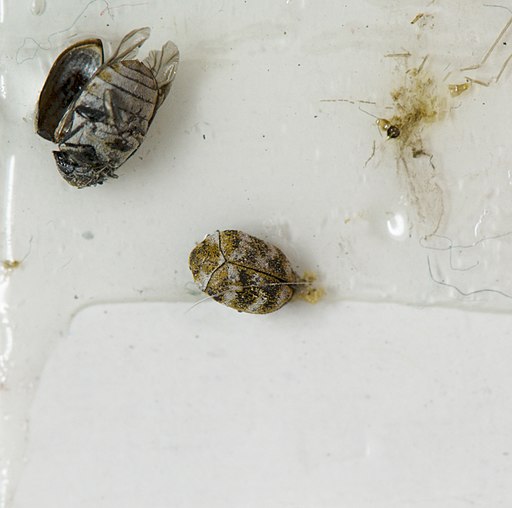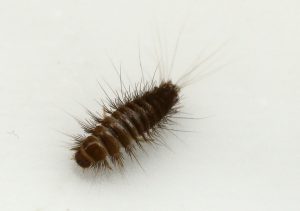CARPET BEETLES
OVERVIEW
They have various shades, mainly reddish brown, black and brown.
The larvae of a carpet beetle prefer to develop in dark, isolated places inside the home.
Carpet beetles make their way into homes through tiny cracks, holes in damaged screens and doorways.
Their larvae can cause slight skin infections, but other than that, they don’t pose a major threat to human health.
APPEARANCE
Adult Carpet beetles vary in their size and appearance from species to species. Normally, they range in size from 1/8th to 3/16th of an inch. They have various shades, mainly reddish brown, black and brown.
The shape of their body is oval and bears a striking resemblance to the body of a ladybug’s. Their larvae have a brown color and have a bristly surface.
TYPES OF CARPET BEETLES
Black Carpet Beetle (Attagenus unicolor)
They have a distinct glowing-black color and brown markings on their legs. Their bodies range in length from 1/8 to 3/16th of an inch. The larvae occupy hidden spots inside your home and are the only ½ of an inch in length.
They are golden to dark brown in appearance and have a flattened, elongated body, which more or less resembles a carrot. They also have a cluster of bristles at their rear end.
Furniture Carpet Beetle (Anthrenus flavipes)
Adults of this species are 1/16 to 1/8th of an inch in length. They have an oval body shaped, and yellow, black and white scales all over their bodies. Their underbellies have a strikingly white color.
Their larvae are covered with hardened and upright brown bristles. Their body is tapered and has 3 tufts of hairs on either end.
Varied Carpet Beetle (Anthrenus verbasci)

Varied carpet beetle by André Karwath [CC BY-SA 2.5]
BEHAVIOR
Carpet beetles make their way into homes through tiny cracks, holes in damaged screens and doorways. Outdoor lighting attracts carpet beetles in numbers. They can also enter your home through infrastructure that has already been damaged by a prior infestation.
After getting access to the inside of your home, they chip away at wool carpets, stuffed animals, plants, furs, rugs, book bindings, leather and pet and human hair. Most species also fill their appetites on nectar and pollen of plants.
HABITAT
The larvae of a carpet beetle prefer to develop in dark, isolated places inside the home. You may find them perched under baseboards, under sofas and beds, in woolen material, cupboards, and even air ducts.
If you have rodent nests, especially wasp and mice infestations festering inside your home, you are likely to find an army of carpet beetle larvae there. They hide in the fur of pets, stuffed animals, as well as dead rodents.
They also lay waste to grains and cereal products. If you see flying carpet beetles near windows, there is a big chance that your home is swarming with their larvae.
LIFE CYCLE AND REPRODUCTION
Carpet beetles go through complete metamorphosis, which comprises of 4 stages ― egg, larva, pupa, and adult. The total period of the life cycle is anywhere between two months to several years. The availability of food plays a vital role in the development of carpet beetles.
Eggs & Larvae
The adult female deposits her eggs in a hidden and dark place indoors, or in the nests of mice, birds, and other animals. It has the capability to produce more than 100 eggs in a single go after mating.
The larvae take at least 35 days to hatch. Adults are highly adept at flying, allowing them to move from one location to another with ease. Their larvae survive on fur, silk, wool and other natural fabrics. They can withstand unfavorable conditions for several weeks.
Pupae & Adults
The pupa develops into an adult carpet beetle in either spring or summer. The time taken for a pup to develop into an adult varies from species to species, and environmental factors.
Mostly, it takes anywhere from 9 months to two years. Adults have a very limited lifespan. They are unable to survive for more than 2-3 weeks.
SIGNS OF INFESTATION

Varied carpet beetles, caught on a sticky blunder trap by the staff of York Museums Trust [CC BY-SA 4.0 ]
- Look out for these signs if you are wary of a carpet beetle infestation.
- Look for larvae and eggs in hidden and inaccessible parts of your homes, especially under radiators, under carpets, and far-off sections of upholstered furniture.
- Look for discarded skin and fecal pellets on clothes, carpets and other material composed of natural fibers.
THREATS AND DAMAGE
Their larvae can cause slight skin infections, but other than that, they don’t pose a major threat to human health. However, when it comes to items, foundations, and structures, they can cause damage on a massive scale. A Carpet beetle infestation shouldn’t be taken lightly. Not only are these pesky pests hard to eliminate, but also difficult to spot.
PREVENTION TIPS
- Vacuum your house, leaving no room untouched. Make sure the carpets, baseboards, hard to reach places inside furnaces and upholstered furniture is properly vacuumed.
- Dry-clean clothes made out of natural fibers to ensure that there aren’t any carpet beetles on them.
- Conditioning registers are an ideal place for a carpet beetle to live in. Vacuum it to remove traces of lint to deter their entry.
- Destroy discarded carpeting, pillows that are no longer in use, and dried flower arrangements.
- Intense cold can kill most pests, including carpet beetles. Just wrap your clothes and other fabrics in a big cloth and place it inside the freezer for at least 48 hours to get rid of carpet beetles for good.

